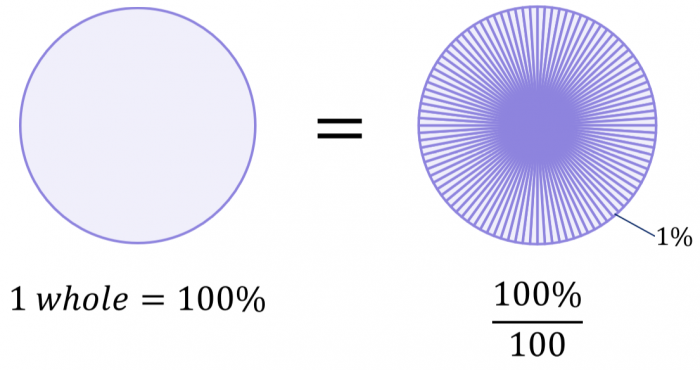Percentage Increase
When a quantity increases by a certain percentage, a part of the whole amount is being added on top of the original, so you have more of the quantity than you had before.
There are two main methods for calculating percentage increases; the first method is slightly simpler to understand, but the second method is much more efficient and useful for more complicated question types.
Method 1 – Find 1% first
Finding 1% of a quantity is often useful because once you know 1% you can easily calculate any other percentage you need based on that information.
If you know what 1% of something is, then it is easy to calculate, for example:
- 20%, because you simply take 1% and multiply it by 20; or
- 52%, because you simply take 1% and multiply it by 52; or
- 87.3%, because you simply take 1% and multiply it by 87.3, and so on.
Calculating 1% of a quantity is very easy:
To calculate 1%, divide the original figure by 100.
This is literally just splitting your original quantity into 100 smaller chunks which together add back up to the original amount, like a pie chart with 100 evenly sized slices:

With this in mind, let’s introduce a key concept:
If you are increasing a quantity by a certain percentage, then the new total percentage must be greater than 100%.
For example, suppose the price of a pair of shoes in a shop is £100 – this represents 100% (i.e. the full amount) of the original price since it has not been increased or decreased yet. Now if the price increases by 15%, then the new price must be the original price (100%) plus the 15% increase, for a total of 115%. Makes sense right?
Follow this worked example:
A house is worth £250,000 when purchased, and over time prices in the neighbourhood have increased by 20%. What is the new price of the house?
\begin{aligned}\text{Original price}&=£250,000=100\% \\[8pt]1\%&=\frac{£250,000}{100}=£2,500 \\[12pt]20\%&=1\%\times 20=£2,500\times 20=£50,000 \\[22pt]\text{New price}&=\text{Original price}+20\% \\[12pt]&=£250,000+£50,000 \\[12pt]&=£300,000\end{aligned}
Method 2 – Use decimal percentages
Using percentages in decimal form (refer to the previous module if you’re unsure how to convert between decimals and percentages) is a more efficient way to tackle these sorts of problems.
Using the same example as before:
A house is worth £250,000 when purchased, and over time prices in the neighbourhood have increased by 20%. What is the new price of the house?
We have established that if a price increases by 20%, then the new price must be the original price (100%) plus the 20% increase, for a total of 120%.
So, we need to find 120% of the original price. We can do this by multiplying our original price by 1.20 (since this is 120% in decimal form). Think of this multiplication as “asking” for the percentage you actually want:
\begin{aligned}\text{New price}&=\text{Original price}\times 1.20\\[12pt]&=£250,000 \times 1.20 \\[12pt]&=£300,000\end{aligned}
As you can see, this returns exactly the same answer as the previous method (but with a lot less working involved!) Not only does it involve less working, but Method 2 also allows you to use percentages in more sophisticated ways (see the “Compounding” topic later in this module). Method 2 is both simpler and yet more powerful than Method 1, which is why it is the superior method.
Now that you know both methods, let’s understand the different ways you may need to use that information. There are two ways to ask about percentage increases:
1) Increasing a quantity by a certain percentage
2) Calculating the percentage increase between two given quantities
Let’s look at each question style in turn:
1) Increasing a quantity by a certain percentage
This sort of question is just like the example of the house we used when learning Method 1 and Method 2. You have a certain figure, and you have to increase it by a given percentage. I will answer all of the examples using both methods, but again I would stress that Method 2 is the best method.
Example 1
Stevenʼs salary is £18,000 and he is due to get a salary increase of 12%. What will his new salary be?
Method 1:
\begin{aligned}\text{Original salary}&=£18,000=100\% \\[8pt]1\%&=\frac{£18,000}{100}=£180 \\[12pt]12\%&=1\%\times 12=£180\times 12=£2,160 \\[22pt]\text{New salary}&=\text{Original salary}+12\% \\[12pt]&=£18,000+£2,160 \\[12pt]&=£20,160\end{aligned}
Method 2:
If Steven’s salary is to increase by 12% then his new salary must be his original salary (100%) plus the 12% increase, for a total of 112% (i.e. we need to multiply by 1.12):
\begin{aligned}\text{New salary}&=\text{Original salary}\times 1.12 \\[12pt]&=£18,000\times 1.12 \\[12pt]&=£20,160\end{aligned}
Example 2
A carton of orange juice contains 540ml. A special offer carton contains an extra 35%. How many millilitres of orange juice are in the special offer carton?
Method 1:
\begin{aligned}\text{Original volume}&=540ml=100\% \\[8pt]1\%&=\frac{540ml}{100}=5.4ml \\[12pt]35\%&=1\%\times 35=5.4ml\times 35=189ml \\[22pt]\text{New volume}&=\text{Original volume}+35\% \\[12pt]&=540ml+189ml \\[12pt]&=729ml\end{aligned}
Method 2:
If the special offer carton contains 35% more juice, then the new volume must be the original volume (100%) plus the 35% extra, for a total of 135% (i.e. we need to multiply by 1.35):
\begin{aligned}\text{New volume}&=\text{Original volume}\times 1.35 \\[12pt]&=540ml\times 1.35 \\[12pt]&=729ml\end{aligned}
2) Calculating the percentage increase between two given quantities
I actually think this type of question is even simpler than the first type. As a quick illustration, if we return to Example 1 from the section above:
Stevenʼs salary is £18,000 and he is due to get a salary increase of 12%. What will his new salary be?
We already calculated the answer to be £20,160 (since his salary increased by £2,160). So, if this question was instead re-phrased as follows:
Stevenʼs salary was £18,000 and it recently increased to £20,160. What was his salary increase in percentage terms?
How would you approach it? Well you already know the answer is 12%, since this was the percentage increase we used previously to calculate his new salary. But if we pretend we don’t know this, how would you calculate it?
To work out percentage change (increase or decrease) between two quantities, take the new quantity and divide by the original quantity, then subtract 1:
\begin{aligned}&\\[6pt]\boldsymbol{\%}\ \textbf{Change}&=\boldsymbol{\frac{\textbf{New quantity}}{\textbf{Original quantity}}-1} \\[6pt]&\end{aligned}
Doing this we find:
\begin{aligned}\text{Percentage change}&=\frac{\text{New salary}}{\text{Old salary}}-1 \\[12pt]&=\frac{£20,160}{£18,000}-1 \\[12pt]&=1.12-1 \\[12pt]&=0.12=12\%\end{aligned}
Example 3
In January Nathan worked a total of 30 hours and in February he worked 45 hours – by what percentage did Nathan’s working hours increase in February?
\begin{aligned}\text{Percentage change}&=\frac{\text{New hours}}{\text{Old hours}}-1 \\[12pt]&=\frac{45}{30}-1 \\[12pt]&=1.50-1 \\[12pt]&=0.50=50\%\end{aligned}
Example 4
There were 16,000 people at a festival last year, but this year there were 18,240. By what percentage has festival attendance increased?
\begin{aligned}\text{Percentage change}&=\frac{\text{New attendance}}{\text{Old attendance}}-1 \\[12pt]&=\frac{18,240}{16,000}-1 \\[12pt]&=1.14-1 \\[12pt]&=0.14=14\%\end{aligned}
Percentage Decrease
Percentage decrease questions are often perceived to be more challenging than percentage increase questions, but they really aren’t.
The one rule to keep in mind when attempting percentage decrease questions is:
To decrease by \boldsymbol{x}% is the same as keeping \boldsymbol{(100-x)}%
As a few quick examples:
- Decreasing by 5% is the same as keeping (100-5)=95%. In other words, instead of thinking of this as losing 5%, think of this as keeping 95%.
- Decreasing by 22.2% is the same as keeping (100-22.2)=77.8%. In other words, instead of thinking of this as losing 22.2%, think of this as keeping 77.8%.
Just as with percentage increase questions, there are two ways to ask about percentage decreases:
1) Decreasing a quantity by a certain percentage
2) Calculate the percentage decrease between two given quantities
You can technically use both Method 1 (working out 1% first) and Method 2 (using decimal percentages) that we learned in the percentage increase topic to handle percentage decrease questions, but as we learned in that topic, Method 2 is by far the better method, so I will use Method 2 for all the examples in this topic.
1) Decreasing a quantity by a given percentage
Example 1
A house was worth £440,000 but prices in the area have fallen by 6% over the last year. What is the value of the house now?
If the house’s value has fallen by 6% then the new value must be the original value (100%) minus the 6% that has been lost, leaving a total of 94%. In other words, instead of thinking of this as losing 6%, think of this as keeping 94% (i.e. we need to multiply by 0.94), and we calculate as follows:
\begin{aligned}\text{New value}&=\text{Original value}\times(100-6)\% \\[12pt]&=£440,000\times 94\% \\[12pt]&=£440,000\times 0.94 \\[12pt]&=£413,600\end{aligned}
Be aware that a slightly reworded question could have also asked us to calculate how much the value has actually fallen in £ terms, in which case there would be one final step to the question:
\begin{aligned}\text{Value decrease}&=\text{Original value}-\text{New value} \\[12pt]&=£440,000-£413,600 \\[12pt]&=£26,400\end{aligned}
Example 2
A jar of sweets contained 136 sweets yesterday, but customers bought 12.5% of them today. How many sweets are left in the jar?
If 12.5% of the sweets have been purchased, then the sweets left in the jar must be the original value (100%) minus the 12.5% that have been purchased, leaving 87.5% remaining in the jar. In other words, instead of thinking of this as losing 12.5%, think of this as keeping 87.5% (i.e. we need to multiply by 0.875), and we calculate as follows:
\begin{aligned}\text{New sweets}&=\text{Original sweets}\times(100-12.5)\% \\[12pt]&=136\times 87.5\% \\[12pt]&=136\times 0.875 \\[12pt]&=119\end{aligned}
2) Calculating the percentage decrease between two given quantities
We use exactly the same technique here as we did when calculating the percentage increase between two quantities in the previous topic. Recall:
To work out percentage change (increase or decrease) between two quantities, take the new quantity and divide by the original quantity, then subtract 1:
\begin{aligned}&\\[6pt]\boldsymbol{\%}\ \textbf{Change}&=\boldsymbol{\frac{\textbf{New quantity}}{\textbf{Original quantity}}-1} \\[6pt]&\end{aligned}
Example 3
Last December in Inverness there was a total snowfall of 32cm. This December there was only 24cm – by what percentage has the total snowfall decreased?
\begin{aligned}\text{Percentage change}&=\frac{\text{New snowfall}}{\text{Old snowfall}}-1 \\[12pt]&=\frac{24}{32}-1 \\[12pt]&=0.75-1 \\[12pt]&=-0.25=-25\%\end{aligned}
A: The total snowfall has decreased by 25%.
Note that the negative percentage change indicates a percentage decrease (as expected for this example).
Example 4
Alex has savings of £4,360 and he spends £420 on a new games console. By how much did this purchase reduce Alex’s savings in percentage terms?
\begin{aligned}\text{Percentage change}&=\frac{\text{New savings}}{\text{Old savings}}-1 \\[12pt]&=\frac{4,360-420}{4,360}-1 \\[12pt]&=\frac{3,940}{4,360}-1 \\[12pt]&=0.9037-1 \\[12pt]&=-0.0963=-9.63\%\end{aligned}
A: Alex’s savings have reduced by 9.63%
Key Outcomes
To calculate 1%, divide the original figure by 100.
If you are increasing a quantity by a certain percentage, then the new total percentage must be greater than 100%.
Decimal percentages are the most efficient tool to handle percentage questions.
To decrease by x% is the same as keeping (100-x)% (e.g. decreasing by 20% is the same as keeping (100-20)=80%).
A negative percentage change indicates a percentage decrease.
To work out percentage change (increase or decrease) between two quantities, take the new quantity and divide by the original quantity, then subtract 1.






